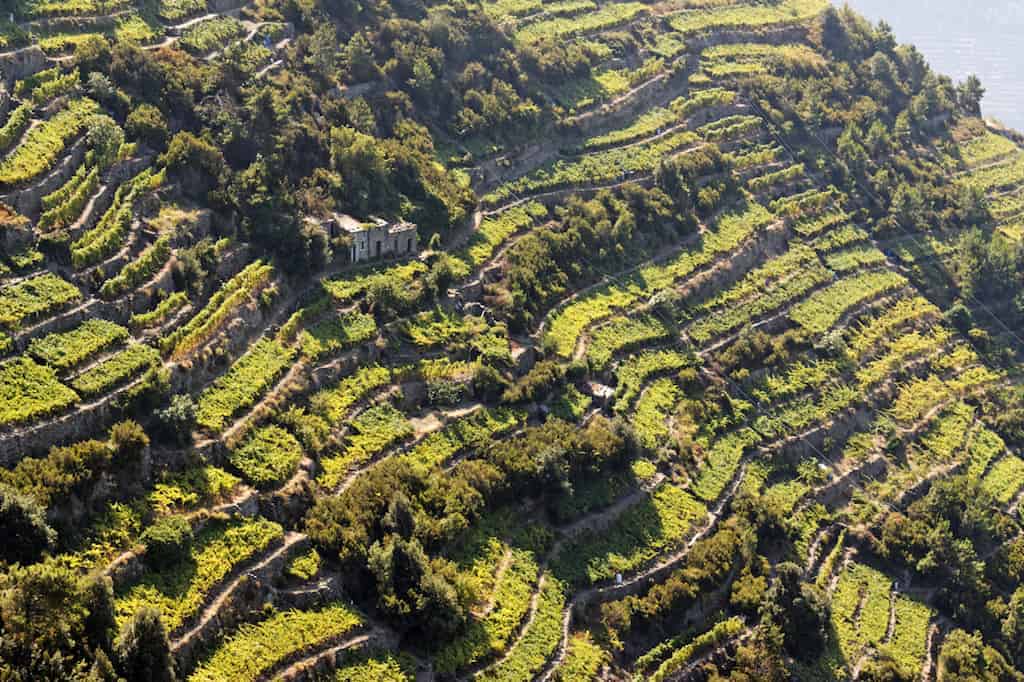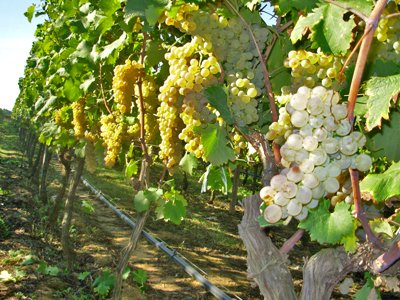Last Updated on August 20, 2022.
Quite possibly one of our favorite summer grape varieties, the Vermentino grape expresses a beautifully refined, light citrus and tree fruit personality. Vermentino is a thin skinned white wine grape. It thrives in warmer climate regions, due to its tendency to ripen quite late in the growing season. The most striking and natural styles of Vermentino wine are typically un-oaked, where they’re able to give off delightful mineral notes in addition to an abundance of other flavors.
Fans of Italian Pinot Gris will likely be intrigued by Vermentino. Luckily for us, this grape variety is incredibly easy to grow, in that it’s resistant to both drought and disease.

Vermentino Origins & Growing Regions
For a long time, there’s been debate as to where this grape variety was born and raised. Today, thanks to improved methods for DNA testing, the general consensus is that Vermentino likely originated in Italy (PDF). Specifically, within the Liguria region, where it’s known as Pigato. However, other analyses point towards Hungary, where the grape is known as Furmint. The question at this time comes down to one thing – which came first?
Vermentino wines today are grown in both Old and New World regions. One of the more popular Old World terms you may already recognize is Rolle, which is the designation given to Vermentino grown throughout Provence and Languedoc-Roussillon in Southeastern France.

It’s also grown extensively throughout Italy, within Gallura, Liguria, Piedmont and the neighboring Italian islands of Corsica and Sardinia (Sardegna). Some of the best tasting Vermentino will come from these maritime areas, where it can grow at elevation and bathe in consistent bright sunlight. Coastal Vermentino grown in calcareous soil while being complimented by salty sea breezes expresses beautiful tree fruit, refreshing acid and chalky mineral tones.
In the New World, Vintners are also finding success with this thin-skinned grape variety as long as the growing season remains warm, bright and long. Producers based in both Lodi, California, along with those located in the up-and-coming region of Hill Country, Texas – are both producing refined and expressive Vermentino varietal wines.
Vermentino Wine Taste & Aroma Profile
It’s important to note that while Vermentino is traditionally a lighter-bodied, upbeat citrus & tree fruit based wine, it’s not always this consistent. Depending on where it’s grown and how it’s crafted, it can also exhibit richer characteristics. For instance, in Bolgheri, Tuscany – along the coast – grapes are exposed at length to both skins and lees. Compounded with barrel aging, these wine-making techniques will yield a bigger body and big hints of green apple pie.
Some producers use this grape to produce sweet white blends as well. Below, we’ll lay out some of the more prevalent tasting notes for Vermentino.
Learn About These Other Wine Grape Varieties
Written By Greig Santos-Buch
Greig Santos-Buch is a Co-Founder at Winetraveler, WSET II Merit wine thought-provoker and off-the-beaten-path outdoorsman. He first became involved with wine traveling after a month-long solo trip to Spain about 10 years ago, planning the trip almost exclusively around the gastronomic scene of the country. Ever since that particular trip abroad, he developed a passion for traveling and making wine tourism the core driver behind where he ends up. This has since led him to exciting destinations including the Czech Republic, to Austria, Germany, Switzerland, France, Italy, Portugal, California, Washington State, Canada and beyond. His primary aim through Winetraveler is to expose this style of travel to the world and make it accessible to everyone.
Fruit
Varied (Tree, Citrus) – Pear, Grapefruit, Green Melon, Lime-peel, Granny Apple
Earth & Mineral Tones
Limestone, Clay, Tumbleweed, Dry Maple Leaf
Additional Complexities
Dry Forest Floor, Geranium, Fresh Ginger, Walnut
Structure & Body
Body Light - Medium
Sugar Dry
Tannins Low
Acid Medium Plus
Alcohol Medium Minus - Medium (11.0% - 12.5% ABV)
Finish Short - Medium
Sushi
Sushi makes for a perfect food pairing with Vermentino wine. Try using lighter-bodied fish or shrimp, along with avocado, mango and spicy mayo. White fish or tempura shrimp are also incredible pairing ideas. Image courtesy Phenu.com.
Fresh Seafood, Grilled Fish, Shellfish
Vermentino is the perfect wine to pair alongside fresh seafood. Anything from raw oysters in lemon butter, to white wine marinated grouper. How awesome does this Prawn, Mango & Carmelized Walnut Avocado salad look?
Mahi-Mahi with Fresh Cilantro Chutney Sauce
Cook it as a dish or throw this ingenious concoction in a taco. Just make sure you're pairing this plate alongside a maritime grown Vermentino from the Old World.
Grilled Grouper with Avocado Lime Sauce
My all time favorite fish, try to snag a fresh filet of grouper if you live by the water in the Southeastern United States. Serve it up alongside a Vermentino from Liguria.
Shrimp Tempura Roll
Checkout this delicious sushi roll, or substitute the shrimp with strips of Yellow Tail.
Shrimp and Mango Summer Rolls with Sweet and Spicy Dipping Sauce
Shrimp, Mango & Mint-based egg rolls, these are a healthy hit and great appetizer concept.
Mango Lime and Avocado Salad
Vegetarian? This recipe has the perfect combination of flavors to be enjoyed as an appetizer alongside any lively Vermentino. Will work equally as well with oaked or sweet versions as well!
Basil Chicken Pesto Penne with Pine Nuts, Garlic & Green Chile Seed
Arguably one of the best possible pairings for herbaceous, fuller-bodied Vermentino, this Chicken Pesto Pasta recipe will knock your guests socks off.